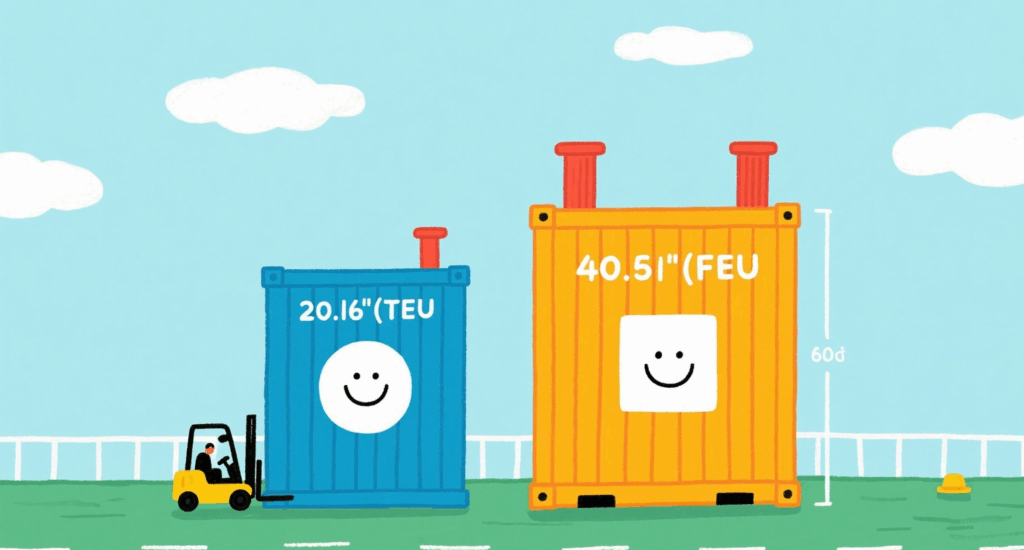- By Della tj
- August 6, 2025
- Uncategorized
1.What Is Empty Shipping Container Weight?
Empty shipping container weight, also called tare weight, refers to the weight of a container when it is completely empty—no cargo, no dunnage, just the container itself.
It includes:
- Steel or aluminum walls
- Floor panels
- Corner castings and locks
- Door fittings and gaskets
Tare weight is marked on the container’s CSC plate and is crucial for:
- Planning container load capacity
- Legal compliance during transport
- Managing freight costs
- Ensuring safety during stacking and lifting
2.Container Weight Classifications
Understanding weight terms helps avoid confusion during shipping:
| Term | Meaning |
|---|---|
| Tare Weight | Weight of the empty container |
| Gross Weight | Total weight of container + cargo |
| Net Weight | Weight of cargo only |
| Payload | Max cargo that can be loaded (gross – tare) |
3.Tare Weights by Container Type
| Container Type | Tare Weight | Max Gross Weight | Max Payload |
|---|---|---|---|
| 20ft Standard | ~2,300 kg | 30,480 kg | ~28,180 kg |
| 40ft Standard | ~3,750 kg | 30,480 kg | ~26,730 kg |
| 20ft High Cube | ~2,600 kg | 30,480 kg | ~27,880 kg |
| 40ft High Cube | ~4,150 kg | 30,480 kg | ~26,330 kg |
| 40ft Reefer | ~4,800 kg | 34,000–36,000 kg | ~29,000–31,000 kg |

4.Standard ISO Container Dimensions
| Container Type | Length (internal) | Width | Height | Volume (Approx) |
|---|---|---|---|---|
| 20ft Standard | 5.9 m | 2.35 m | 2.39 m | ~33.1 m³ |
| 40ft Standard | 12.03 m | 2.35 m | 2.39 m | ~67.5 m³ |
| 40ft High Cube | 12.03 m | 2.35 m | 2.69 m | ~76.4 m³ |
5.Regional Weight Regulations
Different countries have strict weight limits for road transport. Here’s a quick overview:
| Region | Max Weight (Truck + Container) |
|---|---|
| USA | ~36,000 kg (80,000 lbs) |
| EU (varies) | ~40,000–44,000 kg |
| China | ~49,000 kg (varies by province) |
| Australia | ~42,500 kg |
🚛 Exceeding these limits can result in fines, delayed shipments, or cargo being offloaded.
6.Uses for Empty Containers Beyond Shipping
Shipping containers aren’t just for cargo—they’re also used for:
- Storage units (on-site or mobile)
- Container homes or offices
- Pop-up shops and cafes
- Workshops or server rooms
- Emergency shelters
In all these cases, empty shipping container weight affects:
- Foundation requirements
- Crane specifications
- Local transport permits
7.Tools for Measuring & Verifying Weight
To ensure safe and legal loading, use one of these:
- CSC Plate Check – Always check the marked tare weight
- Weighbridges – Fixed scales for vehicles and containers
- Portable Container Scales – For weighing at depots or ports
- SOLAS VGM Submissions – Ensure legal compliance before ocean shipping
8.Why Work with a Freight Forwarder?
Managing containers is more than just booking a ship.
A professional freight forwarder can help with:
- Choosing the right container size and type
- Managing weight limits across regions
- Booking space with carriers
- Handling customs and export documentation
- Saving time and reducing risk
9. TJ Best China Freight: Smart Shipping Starts Here
TJ Best China Freight is a trusted freight forwarder based in China. Whether you need to ship one container or manage a global supply chain, we provide:
- Accurate container sourcing and tare weight info
- Affordable sea and air freight options
- Real-time tracking and delivery coordination
- Expert support from booking to customs clearance
👉 We help manufacturers, importers, and Amazon sellers ship with confidence—worldwide.
10.Final Checklist for Safe Shipping
✔ Check container tare weight on the CSC plate
✔ Ensure total weight doesn’t exceed road/ship limits
✔ Choose container type based on cargo dimensions
✔ Declare Verified Gross Mass (VGM) before sailing
✔ Partner with a freight expert like TJ Best China Freight
Request a Quote
Need a tailored solution for your shipping from China?
Let TJ China Freight Forwarder assist you with reliable, cost-effective service.
FAQ:
Q1.How much does an empty 20ft container weigh?
Around 2,300 kg (5,070 lbs) on average.
Q2.What is the heaviest type of container?
Reefer containers, which weigh up to 4,800 kg due to refrigeration units.
Q3.Do container weights vary?
Yes. Tare weights vary slightly by manufacturer, material, and any modifications.
Q4.Where is tare weight listed?
On the CSC (Convention for Safe Containers) plate, affixed to the container door.
Q5.Can I overload a container if it fits volume-wise?
No. You must stay under the gross weight limit, regardless of volume capacity.
